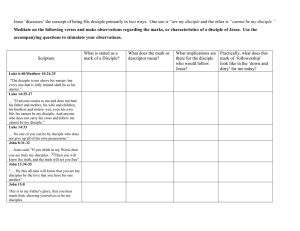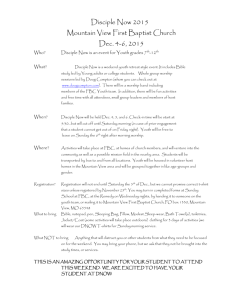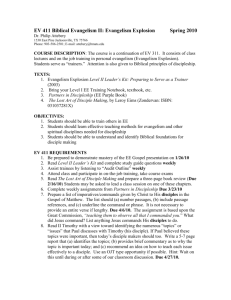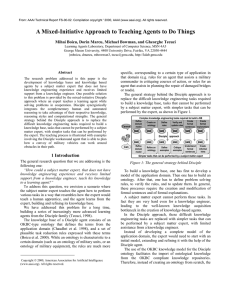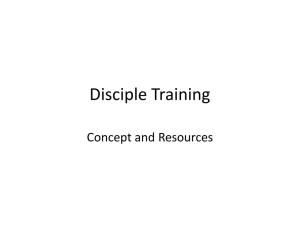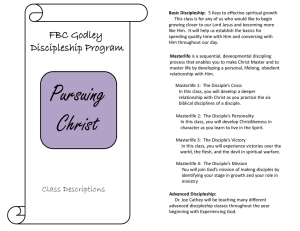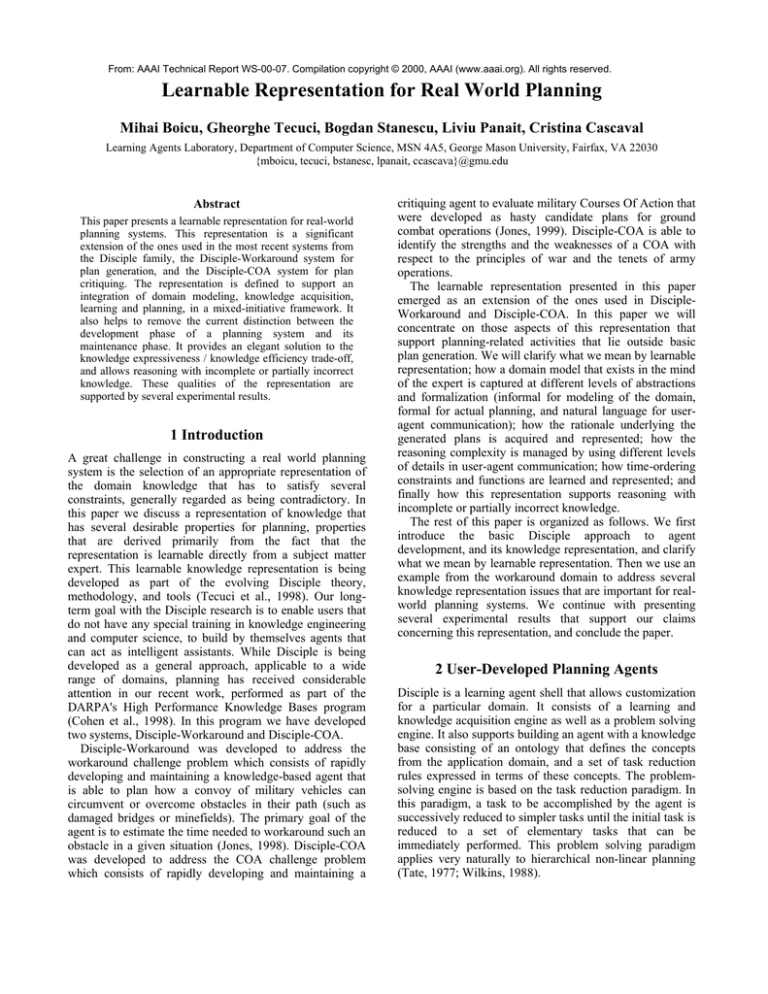
From: AAAI Technical Report WS-00-07. Compilation copyright © 2000, AAAI (www.aaai.org). All rights reserved.
Learnable Representation for Real World Planning
Mihai Boicu, Gheorghe Tecuci, Bogdan Stanescu, Liviu Panait, Cristina Cascaval
Learning Agents Laboratory, Department of Computer Science, MSN 4A5, George Mason University, Fairfax, VA 22030
{mboicu, tecuci, bstanesc, lpanait, ccascava}@gmu.edu
Abstract
This paper presents a learnable representation for real-world
planning systems. This representation is a significant
extension of the ones used in the most recent systems from
the Disciple family, the Disciple-Workaround system for
plan generation, and the Disciple-COA system for plan
critiquing. The representation is defined to support an
integration of domain modeling, knowledge acquisition,
learning and planning, in a mixed-initiative framework. It
also helps to remove the current distinction between the
development phase of a planning system and its
maintenance phase. It provides an elegant solution to the
knowledge expressiveness / knowledge efficiency trade-off,
and allows reasoning with incomplete or partially incorrect
knowledge. These qualities of the representation are
supported by several experimental results.
1 Introduction
A great challenge in constructing a real world planning
system is the selection of an appropriate representation of
the domain knowledge that has to satisfy several
constraints, generally regarded as being contradictory. In
this paper we discuss a representation of knowledge that
has several desirable properties for planning, properties
that are derived primarily from the fact that the
representation is learnable directly from a subject matter
expert. This learnable knowledge representation is being
developed as part of the evolving Disciple theory,
methodology, and tools (Tecuci et al., 1998). Our longterm goal with the Disciple research is to enable users that
do not have any special training in knowledge engineering
and computer science, to build by themselves agents that
can act as intelligent assistants. While Disciple is being
developed as a general approach, applicable to a wide
range of domains, planning has received considerable
attention in our recent work, performed as part of the
DARPA's High Performance Knowledge Bases program
(Cohen et al., 1998). In this program we have developed
two systems, Disciple-Workaround and Disciple-COA.
Disciple-Workaround was developed to address the
workaround challenge problem which consists of rapidly
developing and maintaining a knowledge-based agent that
is able to plan how a convoy of military vehicles can
circumvent or overcome obstacles in their path (such as
damaged bridges or minefields). The primary goal of the
agent is to estimate the time needed to workaround such an
obstacle in a given situation (Jones, 1998). Disciple-COA
was developed to address the COA challenge problem
which consists of rapidly developing and maintaining a
critiquing agent to evaluate military Courses Of Action that
were developed as hasty candidate plans for ground
combat operations (Jones, 1999). Disciple-COA is able to
identify the strengths and the weaknesses of a COA with
respect to the principles of war and the tenets of army
operations.
The learnable representation presented in this paper
emerged as an extension of the ones used in DiscipleWorkaround and Disciple-COA. In this paper we will
concentrate on those aspects of this representation that
support planning-related activities that lie outside basic
plan generation. We will clarify what we mean by learnable
representation; how a domain model that exists in the mind
of the expert is captured at different levels of abstractions
and formalization (informal for modeling of the domain,
formal for actual planning, and natural language for useragent communication); how the rationale underlying the
generated plans is acquired and represented; how the
reasoning complexity is managed by using different levels
of details in user-agent communication; how time-ordering
constraints and functions are learned and represented; and
finally how this representation supports reasoning with
incomplete or partially incorrect knowledge.
The rest of this paper is organized as follows. We first
introduce the basic Disciple approach to agent
development, and its knowledge representation, and clarify
what we mean by learnable representation. Then we use an
example from the workaround domain to address several
knowledge representation issues that are important for realworld planning systems. We continue with presenting
several experimental results that support our claims
concerning this representation, and conclude the paper.
2 User-Developed Planning Agents
Disciple is a learning agent shell that allows customization
for a particular domain. It consists of a learning and
knowledge acquisition engine as well as a problem solving
engine. It also supports building an agent with a knowledge
base consisting of an ontology that defines the concepts
from the application domain, and a set of task reduction
rules expressed in terms of these concepts. The problemsolving engine is based on the task reduction paradigm. In
this paradigm, a task to be accomplished by the agent is
successively reduced to simpler tasks until the initial task is
reduced to a set of elementary tasks that can be
immediately performed. This problem solving paradigm
applies very naturally to hierarchical non-linear planning
(Tate, 1977; Wilkins, 1988).
While an ontology is characteristic to a certain domain
(such as an ontology of military units, or an ontology of
military equipment, in the case of the military domain), the
rules are much more specific, corresponding not only to a
certain type of application in that domain, but even to a
specific expert, representing his or her characteristic
problem-solving strategies (e.g. rules for an agent that
assists a military commander in critiquing courses of
action, or rules for an agent that assists in planning the
repair of damaged bridges or roads). Therefore the rules
and the tasks composing them have to be acquired from the
expert. Based on this observation, the process of
developing a Disciple agent starts with importing an initial
ontology from an external knowledge server, such as CYC
(Lenat, 1995). This process continues with teaching the
agent how to perform various tasks, in a way that
resembles how an expert would teach a human apprentice
when solving problems in cooperation. During this
teaching process, the agent will learn the tasks and the
rules from the expert and will also extend its ontology.
3 Modeling, Planning and Learning
The process of teaching the agent integrates domain
modeling, planning and learning, in a mixed-initiative
framework. The expert selects or defines a planning task
and Disciple tries to automatically generate a plan by
applying the task reduction rules from its knowledge base.
This may produce several good plans, wrong plans, or no
plans at all. Each of these situations is an opportunity for
learning, but let us here consider the case where no
complete plan is produced. In this case the agent will help
the expert to identify the most promising partial plan that
needs to be extended to a complete and correct plan. The
expert and the agent will enter a mixed-initiative modeling,
planning and learning process, working together to
complete the plan. In the same time, the agent will learn
from this joint activity. While trying to reduce a current
task to a set of subtasks, the expert and the agent may
encounter three different situations:
A) No rule is applicable and therefore no reduction is
proposed by Disciple. In this case the expert enters a
modeling phase where he or she has to define the reduction
of the current task. From this example Disciple will learn
both a general task reduction rule and several tasks.
B) A reduction rule is applied to reduce the current task
into subtasks, and the expert accepts it. In this case the rule
may be automatically generalized (depending on how the
reduction was generated) and the planning process
continues with further reducing one of the subtasks.
C) A reduction rule is applied to reduce the current task
into subtasks, but the expert rejects this reduction. In this
case the applied rule is specialized (in a mixed-initiative
scenario) to no longer generate the wrong reduction, and
the process continues as in case A.
Figure 1 shows an example of task reduction provided by
the expert, as a result of a modeling process. In order to
reduce the top level task in Figure 1, the expert formulates
a question that clarifies what aspects of the situation
determine the solution (“What bank needs to be
reduced?”). Then the expert finds and formulates the
answer to the question (“Both site107 and site105”), and
defines the solution (the ordered subtasks shown at the
bottom of Figure 1). All these phrases are in natural
language, except that whenever a reference to a concept or
instance from the ontology is needed, the user has to use
the name of that instance in the ontology (such as
“bulldozer-unit201” or “bank”). The agent assists not only
in identifying the name of an object, but also in structuring
the natural language phrases representing the tasks (as
shown in Figure 1). In addition, it learns general tasks
patterns from these task examples, as shown in section 4.
Once the example reduction is defined, a mixedinitiative explanation generation process starts in which the
agent will find the explanations of this reduction, shown in
the left and right hand sides of Figure 1. This process is
discussed in section 5. Then, based on the example
reduction and its explanations, the agent will learn the rule
from Figure 2. This rule is refined in future planning
situations of type B or C when it is applicable.
4 Learning of Task Representation
The format of a task in the user provided example is a
compromise between a free natural language description
and a restricted formal representation. The Disciple agent
helps the expert to define the tasks in a predefined
structure, but inside that structure there are no additional
restrictions (except that of using the object names from the
ontology). For instance, the expert expresses the first
subtask of the reduction in Figure 1 in natural language:
“Reduce the slope of site107, by direct cut, using bulldozer-unit201, to
allow the fording of unit10”
A task example must start with a task name (an unrestricted
natural language phrase that does not contain any object
name) and is followed by one or more task description
features. Each task description feature includes at most one
relevant object from the ontology (concept or instance) or a
constant (number or string). Based on this structure,
automatically (or sometimes requiring some minimal help
from the user), the agent will create a general task pattern
that includes generic variables, formal task features, and
plausible version spaces for the ranges of these features.
For instance, the task pattern learned from the above task
example is:
Reduce-the-slope
of ?O1 (pub: (geographical-region) plb: (site107))
by-direct-cut
using ?O2 (pub: (equipment) plb: (bulldozer-unit201))
to-allow-the-fording-by ?O3 ( pub: (modern-military-organization)
plb: (unit10))
While the first time a task is used, the user can define it any
way he or she wants, future uses of this task will have to
use the same structure. These new examples of the task
pattern will be used to learn better ranges for the features
of the task. The structuring of the tasks is also used in
reasoning about task similarities during domain modeling,
planning and learning. Disciple also learns hierarchical
relations between tasks that are used in domain modeling
to support creative reasoning.
In previous versions of Disciple, the user had to first
model the domain, then define the task features, and then
define the tasks based on the defined feature. All these
activities had to be done before using the task in an
example. The new version of Disciple allows all these
activities to take place in the same time, when the example
is defined. Moreover, the user is primarily responsible only
for domain modeling, because the tasks and tasks features
are learned by the agent from the provided model of task
reduction. In the next two sections we will briefly discuss
the mixed-initiative learning of task reduction rules,
starting from the provided example.
5 Mixed-Initiative Explanation Generation
To learn a rule from the example reduction, Disciple needs
to understand why the reduction is correct. Finding the
Ford the river after the reduction of the slope of the banks
at site103
by unit10
which is at site107
and is using bulldozer-unit201
Task to be
reduced
Explanations
explanations of the task reduction is a mixed-initiative
process of searching the agent's ontology, an explanation
being a path of objects and relations in this ontology. This
process is guided by three sources of knowledge: a set of
heuristics for analogical reasoning, the Question and the
Answer corresponding to the reduction to be explained,
and a mixed-initiative process of hint refinement.
The heuristics for analogical reasoning are based on the
similarity relations between the tasks and the features from
Disciple’s knowledge base, and on different types of
structure similarity between the current example and the
existing rules. In essence, Disciple identifies the rules that
include tasks similar to those in the current example. Then
it uses the explanations from which these rules have been
learned as a guide to search for similar explanations of the
current example. It displays the found explanations,
ordered by their plausibility, and asks the expert to select
the correct ones.
Guidance for explanation generation is also provided by
the Question and the Answer from the example that
identify the objects that should be part of the explanation,
even though Disciple does not yet have the ability to
understand these natural language phrases. However, in
order to facilitate explanation generation, we are currently
investigating techniques to partially understand the
Question and the Answer.
Question
What bank needs to be reduced?
Site107 is a bank.
Explanations
Site105 is a bank.
Unit10 has a default-negotiable-slope of 25 and
Site107 has a max-slope of 200 > 25.
Unit10 has a default-negotiable-slope of 25 and
Site105 has a max-slope of 200 > 25.
Site107 is on the opposite-side of site105.
Answer
Both site107 and site105
Reduction
Reduce the slope
of site107
by direct cut
using bulldozer-unit201
to allow the fording by unit10
Restore the traffic link
at site103
for unit10
AFTER
AFTER
Ford
Report that
bulldozer-unit201
has been obtained by unit10
bulldozer-unit201
at site103
AFTER
Reduce the slope
of site105
by direct cut
using bulldozer-unit201
to allow the fording by unit10
AFTER
Figure 1. An example of task reduction
Finally, there is a mixed-initiative process of hint
refinement. A hint might be a fragment of an explanation
(such as an object or a relationship between two objects),
or any other abstraction of an explanation. Both the expert
and the agent can formulate an initial hint, and then each of
them may propose possible hint refinements. The
refinements proposed by the agent are based on an analysis
of the structure of the ontology, and on the analogy with
the hints from which other rules have been learned. The
expert may also guide the agent in proposing various
refinements of the current hint, and then may select the
most promising refinements. This process continues until
the hint is refined to an explanation accepted by the expert.
6 Learning of Plausible Version Space Rules
From the example task reduction and its explanations
shown in Figure 1, the agent automatically generates the
task reduction rule shown in Figure 2. This rule is a
complex IF-THEN structure that specifies one or several
conditions under which the task from the IF part can be
reduced to the tasks from the THEN part. Each rule
includes a main condition that has to be satisfied in order
for the rule to be applicable. Partially learned rules, such as
the one shown in Figure 2, do not contain exact conditions,
but plausible version spaces for these conditions. Each
such plausible version space is represented by a plausible
upper bound condition which, as an approximation, is more
general than the exact (but not yet known) condition, and a
plausible lower bound condition which, as an
approximation, is less general than the exact condition. In
addition to the main condition, the learned rule also
includes generalizations of the Explanations, and of the
Question and its Answer, which basically represent the
same information at higher levels of abstraction and
formalization. This allows the Disciple agent to perform a
wide range of reasoning processes. For instance, the
Question and the Answer help the expert in domain
modeling, by suggesting a certain line of reasoning, when
the expert attempts to reduce a task similar with the one
reduced by the current rule. They are also used by the
natural language generation module of Disciple to generate
the question and answer part of a task reduction step
obtained by applying a rule. Representing knowledge in a
rule at various levels of abstractions allows the Disciple
agent to generate the justifications of its solutions at each
of these levels, as has been demonstrated with DiscipleCOA. The most abstract one included only the initial task,
the sequence of questions and answers, and the final
solution. A more detailed one also included the
intermediate tasks. Finally, the most detailed one also
included the explanations and the rules that generated the
intermediate steps.
As the planning agent learns plausible version space
rules, it can use them to propose routine, innovative or
inventive solutions to the current problems. The routine
solutions are those that satisfy the plausible lower bound
conditions of the task reduction rules and are very likely to
IF the task to accomplish is:
Ford the river after the reduction of the slope of the banks
at ?O1
by ?O2
which is at ?O3
and is using ?O4
and the question
What bank needs to be reduced?
has the answer
Both ?O3 and ?O5.
because
• ?O3 is a bank.
• ?O2 has a default-negotiable-slope of ?N1 and
?O3 has a max-slope of ?N2 > ?N1.
• ?O3 is on the opposite-site of ?O5.
• ?O5 is a bank.
• ?O2 has a default-negotiable-slope of ?N1 and
?O5 has a max-slope of ?N3 > ?N1.
Main Condition
Plausible Upper Bound
Plausible Lower Bound
• ?O1 is geographical-region
• ?O2 is military-unit
default-negotiable-slope ?N1
• ?O3 is bank
max-slope ?N2
opposite-site ?O5
• ?O4 is military-equipment
• ?O5 is bank
max-slope ?N3
• ?N1 ∈ [ 0.0 , 200.0 ]
• ?N2 ∈ (0.0 , 1000.0 ]
> ?N1
• ?N3 ∈ (0.0 , 1000.0 ]
> ?N1
• ?O1 is site103
• ?O2 is unit10
default-negotiable-slope ?N1
• ?O3 is site107
max-slope ?N2
opposite-site ?O5
• ?O4 is bulldozer-unit201
• ?O5 is site105
max-slope ?N3
• ?N1 ∈ { 25.0 }
• ?N2 ∈ { 200 }
> ?N1
• ?N3 ∈ { 200 }
> ?N1
THEN decompose the task into the subtasks:
AFTER
Reduce the slope
Report that
of ?O3
?O4
?T1
by direct cut
has been obtained by ?O3
using ?O4
to allow the fording by ?O2
Ford
AFTER
?O4
?T2
?T1
at ?O1
Reduce the slope
AFTER
of ?O5
?T2
?T3
by direct cut
using ?O4
to allow the fording by ?O2
Restore the traffic link
AFTER
at ?O1
?T4
?T3
for ?O2
Figure 2: The rule learned from the example in Figure 1.
be correct. If such a solution is incorrect, then the corresponding rule is extended with an Except-for condition.
The innovative solutions are those that satisfy the
plausible upper bound conditions. These solutions may or
may not be correct, but each case will lead to a refinement
of the task reduction rules that generated them. Correct
solutions will lead to automatic generalization of the
plausible lower bound condition of the rule. Incorrect
solutions may lead to either the specialization of the
plausible upper bound condition of the rule, or the addition
or refinement of an Except-When condition. To illustrate
this last situation, let us consider that the Disciple agent
generated a solution that was rejected by the expert
because the bank to be reduced was made of rock. This
failure explanation "site105 soil-type rock" will cause the
extension of the rule in Figure 2 with the except-when
plausible version space condition shown in Figure 3. In
future planning situations the updated rule will only be
applied if the Except-When condition will not be satisfied.
During refinement, the rule may be augmented with several
such Except-When conditions.
and because not
• ?O5 has a soil-type of ?O6
Except When Condition
Plausible Upper Bound
Plausible Lower Bound
• ?O5 is geographical-region • ?O5 is site105
soil-type ?O6
soil-type ?O6
• ?O6 is hard-soil
• ?O6 is rock
Figure 3: A learned Except When condition.
The inventive solutions are based on weaker forms of
plausible reasoning (such as partial matching of the
plausible conditions of the rules, and tasks similarity based
on the structure of the ontology). An inventive task
reduction step is based on several rules, and is generally a
novel reduction based on tasks from these rules. From
inventive solutions the agent will learn new plausible task
reduction rules.
One can also notice that the general rule in Figure 2
contains generalized AFTER relations, in its right hand side.
They are also generated automatically from the example in
Figure 1. An important feature of our representation is that
the value of an AFTER relation may be an incomplete
description of a task that may appear in some other part of
the plan being generated. For instance, the first task of the
reduction in Figure 1 (i.e. "Reduce the slope of site107...")
can only start after it has been reported that unit10 has
obtained bulldozer-unit201. This is a very elegant solution
to the generation of nonlinear plans that allowed us to treat
task reductions as if they were independent. Consider, for
instance, a situation that involves a damaged bridge that is
also mined. We can reduce this task into two subtasks, demining the bridge, and installing an AVLB bridge, and
further reduce these subtasks independently. However, in
each case where an important condition is satisfied, we
introduce a Report task that signals this condition.
Similarly, at each point where such a condition is needed,
we would introduce a corresponding AFTER relation. For
instance, in the de-mining planning tree, after the action of
de-mining site107, the near bank of the river, we introduce
the task "Report that site107 has been de-mined..."
Similarly, in the install-AVLB planning tree, the task
"Reduce the slope of site107..." will include an "AFTER
Report that site107 has been de-mined..." This works also
in the cases when the bridge is not mined. Because the
generated plan will not contain any de-mining report, the
corresponding AFTER relation of the action "Reduce the
slope of site105 ..." will be ignored.
The task reduction examples may also contain functions
that are automatically generalized in the learned rules. The
workaround domain made heavy use of functions for
estimating the time required for various operations (such as
reducing the slope of a bank, or emplacing a bridge).
In addition to being learned based on very simple
interactions with a domain expert, the Disciple rules show
a practical solution to the expressiveness/efficiency tradeoff. The different types of conditions of a rule (main,
except-when, for, and except-for) offer it a high level of
expressiveness. Maintaining also generalized justifications
at various levels of abstractions and formalizations
(informal and abstract for Question and Answer; formal
and abstract for the explanations; formal and compiled for
the conditions), allows Disciple to provide justifications of
its actions at each of these levels. On the other hand, the
(compiled) conditions of the rules allow very efficient
reasoning. Notice also that a partially learned rule, such as
the one in Figure 2, is an incomplete and possibly partially
incorrect piece of knowledge. However, as has been shown
above, Disciple could use such rules in various types of
reasoning, from routine to creative.
7 Robustness of the Learned Representation
In the Disciple approach, the whole process of developing
the KB of the planning agent is one of creating and refining
(or adapting) knowledge pieces to better represent the
domain model of the teaching expert. The same operations
are involved in updating the KB in response to changes in
the application environment or in the goals of the planning
agent, that is, in maintaining the planning agent. Therefore,
in the life-cycle of a Disciple planning agent there is no
distinction between KB development and KB maintenance.
If we take into account that the Disciple approach
significantly speeds up the process of KB development (as
demonstrated in the HPKB program), and that,
traditionally, KB maintenance costs are about four times
the (already high) KB development costs, then we can
conclude that Disciple can have a very significant positive
impact on the development and maintenance costs for real
world planning systems.
In addition to its ability to update the task reduction
rules to account for new examples, as presented in the
previous section, Disciple also implements a mechanism of
rule re-generation from (a partial set of) the examples and
the explanations from which it was initially learned. This is
precisely what might be required during KB maintenance
when, for instance, some concepts that appear in the rule
might be deleted from the ontology. In such a case, the
automatic regeneration of the rule, based on the updated
ontology, will lead to a new rule that no longer contains the
concept that was deleted.
Disciple also provides intelligent assistants for ontology
maintenance, such as the delete assistant or the copy
assistant (Boicu et al., 1999), that control the operations on
the ontology, in order to maintain its consistency. Let us
consider, for instance, the deletion of a concept from the
ontology. Many knowledge elements may be affected by
this deletion, such as its subconcepts, features that have the
deleted concept is their ranges or domains, rules that
contain the concept in their conditions, etc. In such a case
the delete assistant engages in a mixed initiative dialog
with the expert in order to identify the best strategies to
update its knowledge, while maintaining its consistency.
8 Experimental Results and Conclusions
Disciple-Workaround and Disciple-COA have been the
subject of intense experimentation during the HPKB
program, and the results obtained support the claims made
in this paper about the suitability of our representation for
developing and maintaining real world planning systems.
Disciple-Workaround demonstrated that a knowledge
engineer can rapidly teach Disciple using Military
Engineering manuals and sample solutions provided by a
domain expert. During the 17 days of DARPA’s 1998
evaluation, the KB of Disciple was increased by 72%
(from the equivalent of 5,920 simple axioms to 10,162
simple axioms) with almost no decrease in performance.
Also, Disciple-Workaround was rapidly extended with new
planning strategies, and was incorporated by Alphatech
into a more complex application presented at EFX’98, the
Air Force’s showcase of the most promising technologies.
With Disciple-COA we achieved two new significant
milestones. For the first time we developed the KB around
an ontology created by another group (Teknowledge and
Cycorp), demonstrating both the feasibility of knowledge
reuse with the Disciple approach, and the generality of the
Disciple rule learning and refinement methods. Moreover,
the Disciple-COA agent was taught even more rapidly than
the Disciple-Workaround agent, and has again
demonstrated a very high performance. In this case,
Disciple was taught jointly by a domain expert and a
knowledge engineer, and its knowledge base increased by
46% in 8 days of evaluation, from a size of 6,229 simple
axioms equivalent to a size of 9,092 simple axioms
equivalent. The final knowledge base contained 801
concepts, 444 object and task features, 360 tasks and 342
task reduction rules. Also, each COA was represented with
around 1,500 facts. The second milestone was the
knowledge acquisition experiment performed at the US
Army Battle Command Battle Lab in Fort Leavenworth,
KS. In this experiment four military experts with no prior
knowledge engineering experience received very limited
training in the teaching of Disciple-COA and then each
succeeded to significantly extend its knowledge base (with
around 275 simple axioms in about 3 hours), receiving
only very limited support from a knowledge engineer.
Our research has emphasized the acquisition of planning
knowledge directly from a subject matter expert. However,
an environment for the development of real world planners
should also include a wide range of powerful tools for a
knowledge engineer, such as those from the Expect system
(Kim & Gil, 1999). Expect guides the user in extending
and updating the KB by deriving expectations from the use
of knowledge pieces and their interdependencies, and by
following knowledge acquisition scripts (Tallis and Gil,
1999). We started to address this issue by developing
various intelligent assistants for KB management.
In the advisable planning system developed by Myers
(1996) the user may guide the plan generation by providing
strategic advice on how to achieve a certain goal (such as
to use a certain object or task). We are considering the
integration of such a capability into Disciple, by enabling it
to learn meta-rules from the expert’s advice received
during the mixed-initiative plan construction.
Acknowledgments. This research was supported by
AFOSR and DARPA through the grants F49620-97-10188 and F49620-00-1-0072. Dorin Marcu, Mike
Bowman, Florin Ciucu, Cristian Levcovici and Marinel
Alangiu have contributed to the development of the current
version of the Disciple system. This paper has also
benefited from the insightful comments of Yolanda Gil.
References
Boicu M., Tecuci G., Bowman M., Marcu D., Lee S.W.
and Wright K., (1999). A Problem-Oriented Approach to
Ontology Maintenance, Proc. of AAAI-99, Workshop on
Ontology Management, Orlando, Florida, AAAI Press.
Cohen P., Schrag R., Jones E., Pease A., Lin A., Starr B.,
Gunning D., and Burke M. (1998). The DARPA HighPerformance Knowledge Bases Project, AI Magazine,
19(4),25-49.
Jones E. (1998). HPKB Year 1 End-to-End Battlespace
Challenge Problem Specification, Burlington, MA.
Jones E. (1999). HPKB Course of Action Challenge
Problem Specification, Burlington, MA.
Kim, J. and Gil, Y. (1999). Deriving Expectations to Guide
Knowledge Base Creation, in AAAI-99/IAAI-99 Proc.,
AAAI Press, CA.
Lenat, D.B. (1995). CYC: A Large-scale Investment in
Knowledge Infrastructure Comm of the ACM 38(11):33-38.
Myers K.L. (1996). Strategic Advice for Hierarchical
Planners, in Principles of Knowledge Representation and
Reasoning, KR-96, San Francisco, CA: Morgan Kaufman.
Tallis, M. and Gil, Y. (1999). Designing Scripts to Guide
Users in Modifying Knowledge-based Systems, in AAAI99/IAAI-99 Proc., AAAI Press, CA.
Tate, A. (1977). Generating Project Networks, In
Proceedings of IJCAI-77, Massachusetts, pp. 888-893.
Tecuci, G. (1998). Building Intelligent Agents: An Apprenticeship Multistrategy Learning Theory, Methodology,
Tool and Case Studies. London, England: Academic Press.
Tecuci, G., Boicu, M., Wright, K., Lee, S.W., Marcu, D.
and Bowman, M. (1999). An Integrated Shell and
Methodology for Rapid Development of Knowledge-Based
Agents, in AAAI-99/IAAI-99 Proc., AAAI Press, CA.
Wilkins, D. (1988). Practical Planning: Extending the
Classical Artificial Intelligence Paradigm, San Mateo, CA:
Morgan Kaufman


